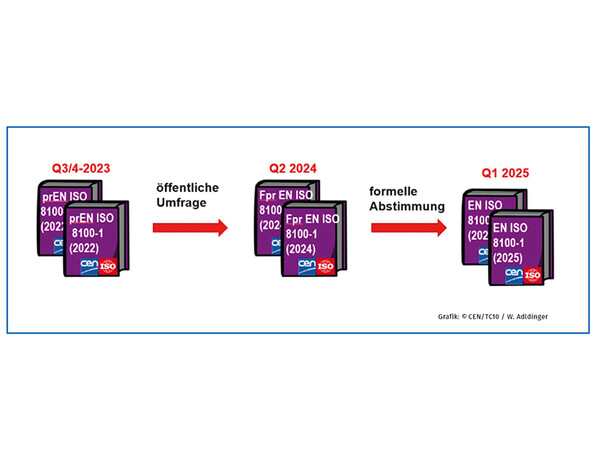EN ISO 8100-1/2: a new era for the lift sector
EN ISO 8100-1/2 – when will these standards finally arrive? Why is it all taking so long? What do the draft standards look like? What will then change? What new technical requirements will there be for lifts, safety components and parts?
By Wolfgang Adldinger
Many companies are already waiting very impatiently what new product requirements will arrive worldwide. If everything goes according to plan, the draft standards prEN ISO 8100-1/2:2023 will likely be published for comment in the fourth quarter 2023 or if necessary, at the beginning of 2024. The publication may also coincide with interlift 23 in October in Augsburg. The chairman of CEN/TC10-WG1 René Hermann hold a talk on this topic at the VFA Forum at interlift.
The publication of the drafts was first planned for Q4 2022, then in Q2 2023 and now in Q4 2023 respectively Q1 2024.
Among other things, the reasons for the long preparation time were:
• EN 81-20/50:2020 had to be adjusted to the state of the art
• There were legal reservations of the EU with over 1,000 comments on the standards
• EN 81-20/50 did not meet the new internal CEN regulations or requirements
• In addition, there were again more than 600 comments on the part of CEN/TC10-WG1 on WD EN ISO 8100-1/2 and on ISO TC 178-WG4, which all had to be checked, processed and answered in detail.
 Photo: © CEN/TC10 / W. Adldinger
Photo: © CEN/TC10 / W. Adldinger State and timeframe
• CEN/TC10-WG1 is still working on the draft standards
• The draft standards will be expected in Q4 2023, if necessary in Q1 2024
• The public enquiry period will be twelve weeks
• The entry into force of EN ISO 8100-1/2 will probably be Q1 2025 respectively Q2 2025
• Transition period three years
• Withdrawal of the previous EN 81-20/50:2020 > Q1 2028, which will then be replaced by EN ISO 8100-1/2:2025
What will change?
• Detailed requirements for horizontal sliding doors / vertical doors
• Solutions to prevent the trapping of fingers / hands (door gap dimensions) in landing and car doors as well as in car entrances
• Installation of vertical car doors combined with hinged doors
• Traction sheave lifts with enlarged floor space
• New alternative suspensions and balancing equipment with attachments
• New requirements for electrical machine brakes and hydraulic opening of the drive brake
• Secure access to the shaft pit using a ladder (new requirements)
• Maintenance platforms in shaft pit
• SIL-evaluated safety circuits (replacement for PESSRAL)
• Emergency automatic rescue device (ARD)
• More precise load-measuring system
• Building requirements in their own annex as part of the area of application
• Detailed Annex ZA (Table ZA.1 and ZA.2)
• Change in complete numbering compared to EN 81-20/50
• All relevant documents such as type test certificates, certificates, conformity declarations, hazard and risk analyses, operating instructions, calculation procedures, acceptance documents, …
Activities by VFA-Interlift
In view of these very comprehensive standard amendments, the standards working group of the VFA-Interlift in the respective standard analysis teams will analyse the individual chapters of prEN ISO 8100-1/2 to process the difference to EN 81-20/50. As soon as the draft standards are available, the work will begin.
Summary and outlook
The future EN ISO 8100-1/2 will inaugurate a new era in the lift sector with the same product requirements and safety standards worldwide.
But this means that individual companies should already be grappling with the new requirements at the end of 2023 / beginning of 2024. Capacities and resources must be planned per company, projects launched depending on product changes and new certifications carried out with the test organisations and the costs incurred will have to be included in the companies’ budget planning.
Based on experience, already being able to deliver in 2025 would be better than waiting until the end of the transition period in 2028 before beginning to operate and deliver according to the new EN ISO 8100-1/2.
The author is the owner of AD-LIFT service and referent at the VFA-Interlift on markets and trends.


























Write a comment